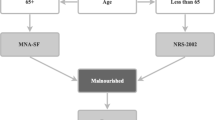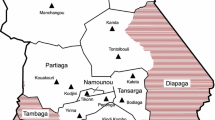Abstract
Objective
Development and validation of a quick and easy screening tool for the early detection of undernourished residents in nursing homes and residential homes.
Design
Multi-center, cross sectional observational study.
Setting
Nursing homes and residential homes.
Participants
The screening tool was developed in a total of 308 residents (development sample; sample A) and cross validated in a new sample of 720 residents (validation sample) consisting of 476 nursing home residents (Sample B1) and 244 residential home residents (sample B2).
Measurements
Patients were defined severely undernourished when they met at least one of the following criteria: BMI ≤ 20 kg/m2 and/or ≥ 5% unintentional weight loss in the past month and/or ≥ 10% unintentional weight loss in the past 6 months. Patients were defined as moderately undernourished if they met the following criteria: BMI 20.1–22 kg/m2 and/or 5–10% unintentional weight loss in the past six months. The most predictive questions (originally derived from previously developed screening instruments) of undernourishment were selected in sample A and cross validated in sample B. In a second stage BMI was added to the SNAQRC in sample B. The diagnostic accuracy of the screening tool in the development and validation samples was expressed in sensitivity, specificity, and the negative and positive predictive value.
Results
The four most predictive questions for undernutrition related to: unintentional weight loss more than 6 kg during the past 6 months and more than 3 kg in the past month, capability of eating and drinking with help, and decreased appetite during the past month. The diagnostic accuracy of these questions alone was insufficient (Se=45%, Sp=87%, PPV=50% and NPV=84%). However, combining the questions with measured BMI sufficiently improved the diagnostic accuracy (Se=87%, Sp=82%, PPV=59% and NPV=95%).
Conclusion
Early detection of undernourished nursing- and residential home residents is possible using four screening questions and measured BMI.
Similar content being viewed by others
References
Morley JE. Anorexia of aging: physiologic and pathologic. Am J Clin Nutr 1997;(66):760–773.
Hickson M. Malnutrition and ageing. Postgrad Med J 2006 Jan;82(963):2–8.
Suominen M, Muurinen S, Routasalo P, et al. Malnutrition and associated factors among aged residents in all nursing homes in Helsinki. Eur J Clin Nutr 2005 Apr;59(4):578–583.
Halfens RJG, Janssen MAP, Meijers JMM, et al. Landelijke Prevalentiemeting Decubitus en andere zorgproblemen: Herziene resultaten zevende jaarlijkse meting 2004. ISBN 90-806663-5-1. Maastricht: Universiteit Maastricht, sectie verpleegwetenschap; 2004.
Halfens RJG, Janssen MAP, Meijers JMM, et al. Rapportage resultaten Landelijke Prevalentiemeting Zorgproblemen 2005. ISBN-10: 90-8-6663-6-X. Maastricht: Universiteit Maastricht: sectie Verplegingswetenschap; 2005.
Halfens RJG, Janssen MAP, Meijers JMM. Rapportage resultaten Landelijke Prevalentiemeting Zorgproblemen 2006. Maastricht: Datawyse/Universitaire Pers Maastricht, 2006.
Halfens RJG, Meijers JMM, Neyens JCL, et al. Rapportage resultaten Landelijke Prevalentiemeting Zorgproblemen 2007. Maastricht: Datawyse / Universitaire Pers Maastricht; 2007. Report No.: ISBN: 978-90-806663-8-2.
Guigoz Y, Lauque S, Vellas BJ. Identifying the elderly at risk for malnutrition. The Mini Nutritional Assessment. Clinical Geriatric Medicine 2002 Nov;18(4):737–757.
Rubenstein LZ, Harker JO, Salva A, et al. Screening for undernutrition in geriatric practice: developing the short-form mini-nutritional assessment (MNA-SF). J Gerontol A Biol Sci Med Sci 2001 Jun;56(6):M366–M372.
Stratton RJ, Hackston A, Longmore D, et al. Malnutrition in hospital outpatients and inpatients: prevalence, concurrent validity and ease of use of the ‘malnutrition universal screening tool’ (’MUST’) for adults. Br J Nutr 2004 Nov;92(5):799–808.
Bauer JM, Vogl T, Wicklein S, et al. Comparison of the Mini Nutritional Assessment, Subjective Global Assessment, and Nutritional Risk Screening (NRS 2002) for nutritional screening and assessment in geriatric hospital patients. Z Gerontol Geriatr 2005 Oct;38(5):322–327.
Guigoz Y, Vellas B. The Mini Nutritional Assessment (MNA) for grading the nutritional state of elderly patients: presentation of the MNA, history and validation. Nestle Nutr Workshop Ser Clin Perform Programme 1999;1:3–11.
Guigoz Y, Vellas B, Garry PJ. Assessing the nutritional status of the elderly: The Mini Nutritional Assessment as part of the geriatric evaluation. Nutr Rev 1996 Jan;54(1 Pt 2):S59–S65.
Vellas B, Guigoz Y, Garry PJ, et al. The Mini Nutritional Assessment (MNA) and its use in grading the nutritional state of elderly patients. Nutrition 1999 Feb;15(2):116–122.
Kruizenga HM, Seidell JC, de Vet HC, et al. Development and validation of a hospital screening tool for malnutrition: the short nutritional assessment questionnaire (SNAQ). Clin Nutr 2005 Feb;24(1):75–82.
Neelemaat F, Kruizenga HM, De Vet HCW, et al. Screening malnutrition in hospital outpatients. Can the SNAQ malnutrition screening tool also be applied to this population? Clinical Nutrition 2008;27(3):439–446.
Schols JMGA, Crebolder HFJM, Van Weel C. Nursing home and nursing home physician: the Dutch experience. JAMDA 2004;(May/June):207–212.
Frank E, Dunlop AL. What does a patient’s outfit weight? Fam Med 2000 Oct;32(9):595–596.
Chumlea WC, Roche AF, Steinbaugh ML. Estimating stature from knee height for persons 60 to 90 years of age. J Am Geriatr Soc 1985 Feb;33(2):116–120.
Margo G. Assessing malnutrition with the mid-arm circumference. Am J Clin Nutr 1977 Jun;30(6):835–837.
Beck AM, Ovesen L. At which body mass index and degree of weight loss should hospitalized elderly patients be considered at nutritional risk? Clin Nutr 1998 Oct;17(5):195–198.
Beck AM, Ovesen L. Body mass index, weight loss and energy intake of old Danish nursing home residents and home-care clients. Scand J Caring Sci 2002 Mar;16(1):86–90.
Pauly L, Stehle P, Volkert D. Nutritional situation of elderly nursing home residents. Z Gerontol Geriat 2007;(40):3–12.
Volkert D, Berner YN, Berry E, et al. ESPEN Guidelines on Enteral Nutrition: Geriatrics. Clin Nutr 2006 Apr;25(2):330–360.
Omran ML, Morley JE. Assessment of protein energy malnutrition in older persons, part I: History, examination, body composition, and screening tools. Nutrition 2000 Jan;16(1):50–63.
Sergi G, Perissinotto E, Pisent C, et al. An adequate threshold for body mass index to detect underweight condition in elderly persons: the Italian Longitudinal Study on Aging (ILSA). J Gerontol A Biol Sci Med Sci 2005 Jul;60(7):866–871.
Campillo B, Paillaud E, Uzan I, et al. Value of body mass index in the detection of severe malnutrition: influence of the pathology and changes in anthropometric parameters. Clin Nutr 2004 Aug;23(4):551–559.
McCullagh P. Regression models for ordinal data. J Roy Stat Soc 1980;series B(42):109–142.
Saeglitz C, Volkert D, Lesser S, et al. BMI below 20 is associated with poor outcome in geriatric patients. ESPEN. 2006. 2006. Ref Type: Abstract
Rubenstein LZ, Harker JO, Salva A, et al. Screening for undernutrition in geriatric practice: developing the short-form mini-nutritional assessment (MNA-SF). J Gerontol A Biol Sci Med Sci 2001 Jun;56(6):M366–M372.
BAPEN, the Britisch Association for Parental and Enteral Nutrition. http://www.bapen.org.uk/must_tool.html. 2003. Ref Type: Generic
Woo J, Chi I, Hui E, et al. Low staffing level is associated with malnutrition in longterm residential care homes. Eur J Clin Nutr 2005 Apr;59(4):474–479.
Nijs KA, de GC, Siebelink E, et al. Effect of family-style meals on energy intake and risk of malnutrition in dutch nursing home residents: a randomized controlled trial. J Gerontol A Biol Sci Med Sci 2006 Sep;61(9):935–942.
Author information
Authors and Affiliations
Corresponding authors
Rights and permissions
About this article
Cite this article
Kruizenga, H., De Vet, H., Van Marissing, C. et al. The SNAQRC, an easy traffic light system as a first step in the recognition of undernutrition in residential care. J Nutr Health Aging 14, 83–89 (2010). https://doi.org/10.1007/s12603-009-0147-1
Received:
Accepted:
Published:
Issue Date:
DOI: https://doi.org/10.1007/s12603-009-0147-1




